
Katana Kami: A Way of the Samurai Story Review
Another boss defeated; the mighty Nue fell to my feet. Seeing that my only path forward was to escape the mysterious Jikai dungeon that night, I entered the golden aura thinking my exit was secured. I was wrong.
My screen fell under a sepia tone all of a sudden. I transported to a familiar place, yet something felt off. I wandered toward the faint sounds of a baby crying. A samurai stood in my path. Before I gave him any time to respond, I unsheathed my blade and started my assault but quickly realized he was too much for me!
His health pool was massive. His strikes hurt a lot. I was outmatched, but lady luck blessed me that day. I noticed that my sword was able to make him flinch for just a second if both strikes connected.
I wouldn’t last for another minute so I had to think fast. I scurried over to the side of this man’s home into the bushes. Somehow, I was able to position him toward a corner that he’d have no escape from; it was like trapping a boxer at the corner of a ring and making sure he didn’t have time to catch his bearings.
Stab. Stab. Dodge cancel. Stab. Stab. Dodge cancel.
This slow, but steady onslaught wracked up my combo. A higher combo count meant a higher rate of experience gained and an increased drop rate for items to appear. The man fell to my blade that was on the verge of breaking. The combo count was at a little over 200 meaning that I obtained an absurd amount of experience and the drop rate was at around 95%, so I saw a sword flying out of his body falling to the ground.
It was one of the best swords I found in my entire playthrough of Katana Kami: A Way of the Samurai - and I just barely started it. I wasn’t sure if I was meant to beat that puzzling man at that point, though the whole sequence of events just had me thinking “Yep, this is certainly Way of the Samurai alright.”

Few have fashioned themselves in a manner that the Way of the Samurai games have done. This niche series of games have earned somewhat of a reputation, in part of being so enraptured with its own sense of brand identity. I don’t think they exhibit cream of the crop moment-to-moment gameplay, but there’s a charming aspect to their quirkiness that often makes them a fun ride.
The series has been dormant for awhile now. A new mainline entry hasn’t come out since 2011 with Way of the Samurai 4’s release in Japan on the PS3; it saw an overseas release the following year and received a PC version in 2015. Oddly enough, Way of the Samurai 3 also came out on PC, but it was done after Way of the Samurai 4 and launched in 2016. Katana Kami: A Way of the Samurai Story is not a full-fledged mainline entry. It’s a serviceable spiritual successor to those itching for a new Way of the Samurai experience. Like with all of the other games, this stands alone - even moreso because it’s a spinoff - so newcomers can dive right in without worry of missing out on any details.
Much like the other Way of the Samurai games, Katana Kami is fairly light on its main story. It features a familiar set-up of a lone wandering samurai being somehow entangled in the struggle between three factions. This time the player’s character stumbles upon Dojima’’s daughter getting kidnapped as collateral for his debt and you take it upon yourself to help this blacksmith settle it through payment installments.
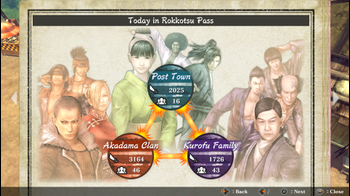
Those expecting a considerable amount of freedom like previous Way of the Samurai titles should be warned - Katana Kami is a different beast altogether and is a relatively scaled down experience. It’s now a roguelite with a tinge of mystery dungeon elements mixed in; if you’re familiar with Shiren the Wanderer, you know what to expect. Katana Kami has players make repeated treks into the enigmatic Jikai dungeon that only appears at night.
Even though Katana Kami has an isometric perspective, a lot of its gameplay systems share the same DNA as previous Way of the Samurai entries. Combat still has the rock, paper, scissors of attacking with your equipped weapon, blocking incoming attacks, and kicking to break blocks. As you can guess from the title, the vast majority of weapons you can use are Japanese swords. Different stances, abilities, and quality levels set them apart from one another. You can equip up to three weapons at once and weapon choice often boils down to player preference.
Weapons can have different attack speeds, swing arcs, and combo strings, even if they share the same stance. My ideal setup, for example, consisted of a low-stance katana that did a quick two pokes before backing off, an iai-stance katana that would rapidly unsheathe the sword repeatedly from its scabbard between strikes, and a large up-stance katana that had surprisingly fast slashes with wide arcs... with a chance of inflicting fatigue upon me per strike. I found the trade-off worth it. If you vehemently dislike swords for some reason, your options are unfortunately limited to bows and going unarmed.
Naturally the more you use a weapon, the more it starts to get worn down. Feeding it weapons at repair spots replenishes its durability and using a weapon of the same stance or a duplicate of that same exact weapon grants a bonus to how much it gets repaired. As weapons level up, you learn new abilities that unlock more of their moveset; levels are sword sensitive though - meaning that a weapon’s levels are locked to that specific sword and not universally shared between all other swords of the same type.
Sword levels are persistent, unlike your base character level. Katana Kami’s roguelite elements manifest in that every time you enter Jikai anew, your character’s level will always start at 1 and will always reset the moment you leave the dungeon. Luckily, a sword’s level remains where it’s at, unless you swap to a new one. This works out to your benefit since every character level up fully replenishes your vitality and stamina.
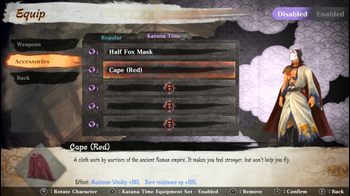
Each sword has a super powered-up mode via Katana Time. It makes your character move faster, attack faster, and makes your equipped sword at the time invincible for a limited time. There are three tiers of Katana Time and fully unleashing it’s all filled up gives a special flashy effect to your attacks too. These often come in the form of elemental onslaughts, like a wall of fire, a surging stream of wind, a geyser of explosions from the earth, and so forth. Each of your three equipped weapons have mutually exclusive Katana Time bars so it’s a good idea to switch between them often to have a healthy stock of Katana Time activations for tougher encounters.
All equippable weapons can be upgraded either at the blacksmith shop where your lone samurai resides or random smithys you stumble upon in your nightly descent. Both attack power and durability can be raised, though each weapon has a cap on how much it can be upgraded. Further customization for them lies in assigning them titles; they’re gradually gained through using a weapon overtime and upgrading them. Applying titles to a weapon uses up title books. You can also transfer a sword’s title into another sword, but doing so will consume the sword itself as well.
If you’ve been conditioned by the Soulsborne games, stamina in Katana Kami works a bit differently; your attacks aren’t restricted by it draining at a rapid rate. Instead, some of your sword abilities may use a tiny portion of it but its primary purpose is to heal your vitality when your sword is sheathed. This allows you the freedom to approach encounters at your own pace; both turtling till you see an opening and staying mobile through frantically dodging around are valid tactics to employ if it’s working out for you. There are also instant kill opportunities with precisely timed guards and dodges too.
Dying in the dungeon isn’t game over, though you do lose everything you had on you - items, weapons, money, and accessories. There is a way to get them back that’s a bit of a hassle, a bit out of the way, and a bit costly. You can safely store these back at Dojima’s shop before dungeon diving.
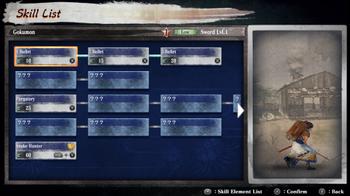
Another thing new to the series is that most of the enemies you’re fighting are all mythological beings. Battling familiar creatures from Japanese folklore like oni, yuki-onna, nekomata, and so on may throw off series veterans, since much of Way of the Samurai has always delved in squaring off against humans. It’s a decent change of pace, though one of my localization pet peeves pops up often in Katana Kami; naming conventions are inconsistent and often clash with one another. For instance, yuki-onna are labeled as a ‘Snow Woman’ yet nekomata remain as such. Normally this wouldn’t bother me too much, but these enemies often show up together making the inconsistency all the more egregious, especially in a setting that’s as involved with Japanese mythology as this game.
All that aside, another inconsistency that bugged me in Katana Kami is the camera’s picky tendency on what it decides to show or not show when an object obfuscates your character and on-screen foes. The game is locked to a certain isometric angle with no option to rotate the camera. If a building blocks your view, the camera will highlight the things it’s blocking in a bright red for enemies and a bright blue for you. This frustratingly doesn’t ring true for other environmental objects; as you go deeper into the dungeon, the environment starts to shift toward jungle-like settings with lots of foliage and sometimes, the camera will happen to be behind a tall tree’s leaves leaving you having to peer through it without the aid of that bright red highlight. There were times I would enter a new floor in the dungeon and the first thing I’d see was just the glory of low polygonal leaves pushed up right against the camera. It was lovely.
When the opportunity arises and you take up the option to leave Jikai for the night, the game moves forth onto the next day. During daytime, there’s a handful of things to do although none of it feels all that engaging. In order to meet the upcoming deadline for each payment (which goes up at an alarming pace), you can’t solely rely on getting lucky in repeated dungeon runs. As I mentioned earlier, Katana Kami carries the long running Way of the Samurai tradition of having three factions struggle among each other and you’ll have to somehow manipulate this for your own goals.
The Kurofu Family, Akadama Clan, and Post Town Faction butt heads throughout the game. You’ll hear about it from the town newspaper and the constant fights that take place outside of the blacksmith shop. In fact, your three shopkeepers in the day are all representatives of each faction but their availability in assisting you is constantly in flux because they often get into fights either with each other or random bypassers. If you need a specific from them like hiring a bodyguard or buying a specific item, it’s often not a bad idea to immediately give them a visit before having to wait the next day if one of them gets roughed up. Luckily even if one of these shopkeepers were to die in battle, there’s always a replacement the following day.
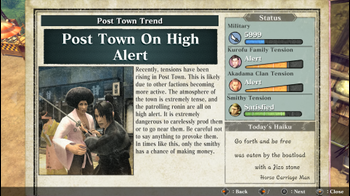
You’ll gradually be building up tensions between these groups as you fulfill sword orders and ship them armaments both from weapons you’ve found and weapons that Dojima produces. There’ll be brief periods when the blacksmith shop booms with business to really rake in the cash as their fights gradually turn into an all-out war. You can choose to take a side between the three, but it makes little difference to the overall story. There is somewhat of a nice change of scenery through visiting your allied group’s headquarters.
Katana Kami’s story is actually about how you manipulate the war economy from the shadows to pay off debt collectors. It probably sounds exciting on paper, yet I didn’t find it all that thrilling actually playing through it. If Katana Kami had the chance to be a proper full-on Way of the Samurai sequel with the same premise, it may have had a more impressive portrayal of it.
When you’re done doing all your prep, you can sleep to pass time into the night - to travel into Jikai once more. There are ways to accelerate your descent through Jikai if you don’t want to go through it one floor at the time into well-worn territory once more. Danger wells, mystery wells, and portals can all skip through floors in different manners; mutators, like berserk enemies or disabling item usage, pop up in the floors inside danger wells and mystery wells have a chance to lead into big treasure floors. Though there’s some amount of variety in traversing the early parts of Jikai, it’s undeniable that the first several minutes into the dungeon gets old fast. It leaves me wishing that there was a more solid, amicable checkpoint upon entry instead of relying on shortcuts.
Traversing into the dungeon doesn’t have to be a lonely endeavor though. As I briefly touched upon earlier, you could hire a bodyguard to help you out. Turning on the game’s network connectivity functions can also potentially net you a co-op partner… depending on how long they want to work with you. There are settings you can toggle to limit the pool to either randomly just meeting up with AI NPCs or expanding that to real people too. When you encounter them in a dungeon, you can throw up an emote sign to signify whether you’re a friend or foe; the caveat is that this can be switched at any time. If you’re one for thrills and surprises, take a gamble and see if you can really trust the person fighting alongside you. As time goes on, you might find a lot of great loot and they may want in on that. Sadly, there’s no way to host a private session to travel together with your friends at this time. There's also a bounty board that keeps track of several individuals to be on the look out for; if you're in need of cash fast, some of their payouts are a bit lucrative.
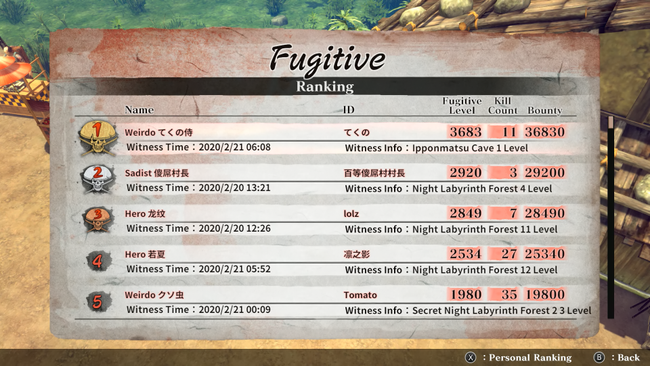
I could never really shake off my irritation of the game’s strict inventory limit on your character. It’ll fill up fast if you’re picking up everything in sight and you’ll eventually have to train yourself on how to be picky with what you’re picking up or you’ll be spending a lot of time in menus deciding what to discard and what to keep. I eventually reached a point on how to travel light only carrying the bare necessities when it comes to consumables; the rest is a delicate balance between repairment fodder, shop resupplying for sword orders, and high-value items that can be sold for a lot. Several accessories do slightly increase the limit, but it’s never enough.
This is pretty much Katana Kami’s gameplay loop and doesn’t deviate from it all that much. There are multiple endings, albeit not as much as past titles. Its biggest selling point is how engaging the combat can be once you’ve found a set of weapons that you enjoy controlling. Being a small-scaled spin-off did hamper some of its more ambitious ideas. Nevertheless, Katana Kami: A Way of the Samurai Story isn’t quite the Way of the Samurai game I wanted but that doesn’t make it terrible; there is just an untapped well of potential that it ultimately fails to reach though.